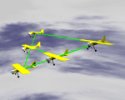Flocks of unmanned aircraft form Bluetooth Linux clusters
May 16, 2005 — by Henry Kingman — from the LinuxDevices Archive — views Researchers at the University of Essex are using Linux and tiny embedded computer modules to build fleets of unmanned aircraft that fly in flocking formations like birds, while performing parallel, distributed computing tasks using Bluetooth-connected Linux clustering software.
Researchers at the University of Essex are using Linux and tiny embedded computer modules to build fleets of unmanned aircraft that fly in flocking formations like birds, while performing parallel, distributed computing tasks using Bluetooth-connected Linux clustering software.
The project is being undertaken by members of Essex University's Computer Science and Electronic Systems Engineering departments, and is led by Dr. Owen Hollands, who heads the computer science research department.
The project includes two branches. The Gridswarm branch will use model aerobatic trainers equipped with auto-pilot systems and capable of flying at speeds of 120mph. The UltraSwarm branch, meanwhile, will work on an “indoor” version, based on small helicopters with co-axial rotors.
PhD candidate Renzo de Nardi recently completed a prototype UltraSwarm device, a craft the project believes to be the smallest flying web server in the world. Once the whole flock has been completed, the onboard computers will be configured as a Piconet (a network of devices connected in an ad hoc manner via Bluetooth), “with the master on the arena-based computer system,” Hollands says.
The photo below shows de Nardi's prototype serving a web page — including an image from its onboard camera — via an onboard http server connected to the laptop via a Bluetooth link.

The first UltraSwarm prototype, the “indoor” version of Gridswarm
(Click to enlarge)
The project grew out of an earlier project involving groups of wireless connected, autonomous Linux robots that Dr. Holland worked on while still a university student, in 1999. He observed that the robots could potentially be configured as a distributed computing cluster, using Beowulf software for Linux. However, available mobile computing platforms at the time had insufficient resources to make such applications practical.
According to mobile computing module maker Gumstix, the Gridswarm and UltraSwarm projects are making use of its “Gumstix” computing modules — tiny computer boards about the size of a stick of gum, but powered by the same Intel XScale processor often used in PDAs, Linux smartphones, and other relatively powerful mobile multimedia devices.
 The Gumstix modules measure 3.1 x 0.8 x 0.3 inches (20 x 80 x 8mm), and weigh “less than a tablespoon of water,” according to Gumstix. They are powered by an XScale (ARM-based) Intel PXA255 SoC (system-on-chip) running at 200MHz or 400MHz. They include 64 MB of SDRAM, 4 MB of Flash, and a complement of peripherals and I/O that includes an LCD controller, two RS232 serial ports, a USB 1.1 device port, I2C, two NSSP PWMs, AC97, and a JTAG port. The modules are designed to be powered from two NiMH batteries, or by a single lithium-ion or lithium-polymer battery. They require a 4.5 or 5V input, and dissipate under 200 mA (200 MHz) or under 250 mA (400 MHz), Gumstix claims.
The Gumstix modules measure 3.1 x 0.8 x 0.3 inches (20 x 80 x 8mm), and weigh “less than a tablespoon of water,” according to Gumstix. They are powered by an XScale (ARM-based) Intel PXA255 SoC (system-on-chip) running at 200MHz or 400MHz. They include 64 MB of SDRAM, 4 MB of Flash, and a complement of peripherals and I/O that includes an LCD controller, two RS232 serial ports, a USB 1.1 device port, I2C, two NSSP PWMs, AC97, and a JTAG port. The modules are designed to be powered from two NiMH batteries, or by a single lithium-ion or lithium-polymer battery. They require a 4.5 or 5V input, and dissipate under 200 mA (200 MHz) or under 250 mA (400 MHz), Gumstix claims.
Additional information about the Gridswarm project — including VRML models of the aircraft and a short movie of a flight to test the stripped down color spycamera can be found on the project's website. Dr. Hollands's webpage also mentions the project, as does de Nardi's webpage. The project plans to present a paper at the IEEE Swarm Intelligence Symposium in June.
This article was originally published on LinuxDevices.com and has been donated to the open source community by QuinStreet Inc. Please visit LinuxToday.com for up-to-date news and articles about Linux and open source.